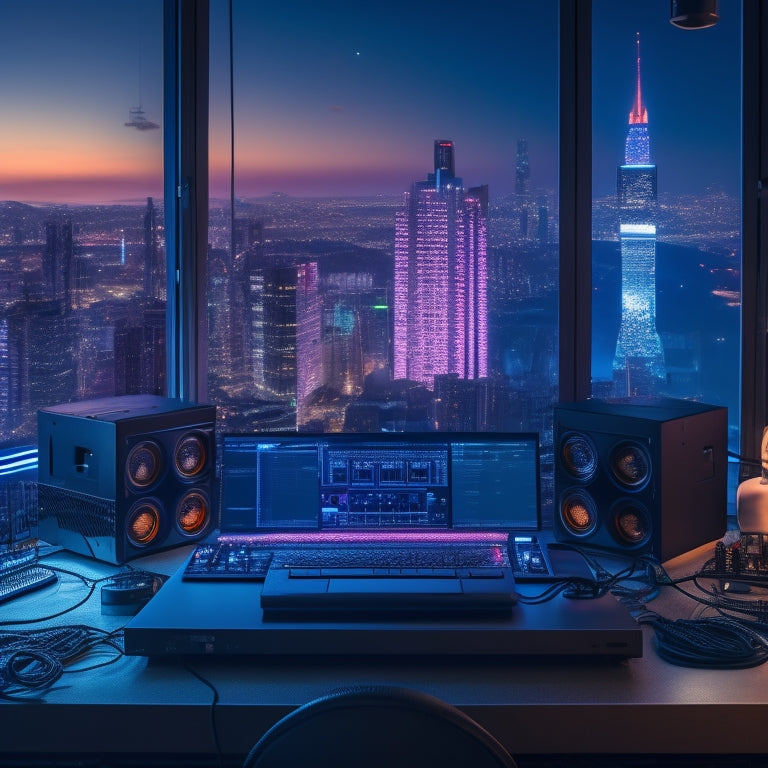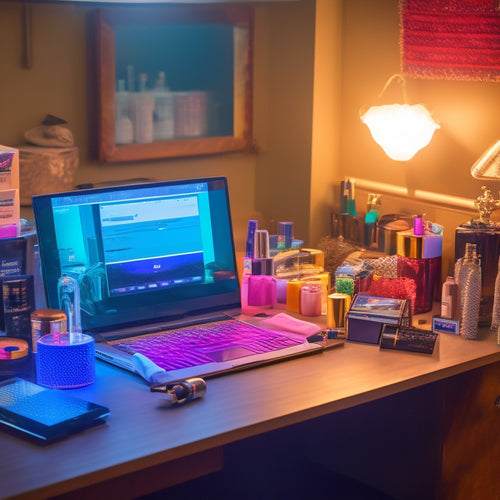
What Music Editing Software Do Festival DJs Use?
Share
You're likely to find top festival DJs relying on a specific set of music editing software to craft their unique sound and deliver electrifying performances. They often use software that allows for beat manipulation, such as frequency shifting and rhythm analysis, to create their signature sound. DJ-friendly audio editing tools with streamlined workflows and intuitive shortcuts also help them focus on creativity. For remixing and mashups, they employ software with seamless looping and multi-track editing capabilities. To take their tracks to the next level, they'll refine their mixing skills and master their tracks to perfection. Now, dive deeper into the world of festival DJs and discover the secrets behind their hits.
Key Takeaways
• Festival DJs often use beat manipulation software like Ableton Live, FL Studio, or Traktor for frequency shifting and rhythm analysis.
• DJ-friendly audio editing tools like Adobe Audition and Logic Pro provide intuitive editing shortcuts and customizable workflows for creative focus.
• Remixing and mashup essentials in software like Serato DJ and WeDJ enable seamless looping and multi-track editing capabilities.
• Sound design software like Massive and Sylenth1 help craft memorable drops with meticulous sound design and layering.
• Mastering software like Ozone and FabFilter Pro-Q ensure high-quality sound and prepare tracks for festival performances.
Software for Beat Manipulation
When preparing for a high-energy festival set, you'll frequently find yourself relying on software that can expertly manipulate beats to get the crowd moving. To take your performance to the next level, you need software that can expertly analyze and manipulate rhythms.
This is where frequency shifting and rhythm analysis come in. Frequency shifting allows you to adjust the pitch of a track without affecting its tempo, creating smooth switches between songs. Rhythm analysis, on the other hand, helps you identify the beat and tempo of a track, making it easier to mix and match songs.
With the right software, you can experiment with different beats and rhythms, creating a unique sound that sets you apart from other DJs. Look for software that offers advanced frequency shifting and rhythm analysis features, allowing you to fine-tune your tracks and create a high-energy set that will keep the crowd dancing all night long.
DJ-Friendly Audio Editing Tools
You'll also need DJ-friendly audio editing tools that let you slice, dice, and rearrange audio files to create unique remixes and mashups that'll keep the festival crowd engaged.
Think of it as a culinary masterclass, but instead of whipping up a soufflé, you're serving up a sonic feast. A good audio editing tool should streamline your workflow, allowing you to focus on the creative process rather than getting bogged down in tedious editing tasks.
Look for software that offers intuitive editing shortcuts, like keyboard shortcuts or customizable workflows, to help you work efficiently. A well-designed audio workflow is key to churning out high-quality mixes quickly.
You want to be able to experiment with different arrangements, test out new ideas, and make adjustments on the fly. With the right tools, you'll be able to tweak, twist, and transform your tracks into something truly unforgettable.
Remixing and Mashup Essentials
When creating remixes and mashups, you'll need software that can handle complex edits and arrangements. You'll want to focus on software essentials that provide advanced editing features, such as multi-track editing and effects processing.
Software Essentials
Frequently, festival DJs rely on software essentials to craft remixes and mashups that electrify the crowd. These tools are the backbone of their creative process, allowing them to experiment and innovate without restriction.
When it comes to remixing and mashup essentials, you need software that provides the right balance of audio workflow and creative freedom.
Here are the must-haves:
-
Seamless Looping: The ability to create seamless loops is vital for building energy and tension on the dance floor. Your software should make it easy to create and adjust loops on the fly.
-
Multi-Track Editing: With multi-track editing, you can work on individual tracks within a remix or mashup, giving you complete control over the final product.
-
Effects and Processing: A robust effects suite is essential for adding depth and texture to your tracks. Look for software that includes a range of processing tools, from reverb and delay to distortion and compression.
Mashup Building Blocks
To craft compelling mashups, start by identifying the core elements that drive the energy of your tracks, such as drum patterns, basslines, and hooks. These building blocks will serve as the foundation for your creative sampling. You'll want to pinpoint the most iconic or catchy parts of each track, and then experiment with combining them in innovative ways. Think of it like building with Legos – you're taking individual pieces and constructing something entirely new.
When it comes to layering, consider the Harmonic Layers approach. This involves blending tracks that share a common key or chord progression, creating a seamless fusion of sounds. It's like cooking a recipe – you're combining ingredients (tracks) in the right proportions to create a dish (mashup) that's greater than the sum of its parts.
Festival-Ready Track Preparation
When preparing tracks for a festival set, you'll want to focus on beat-perfecting techniques to guarantee smooth shifts and a non-stop dance floor.
You'll need to refine your mixing skills to create tight shifts that keep the energy high.
Beat-Perfecting Techniques
You'll need to fine-tune your tracks by implementing precise beat-perfecting techniques to guarantee a seamless festival performance. This is where the magic happens, and your tracks transform into crowd-pleasers. To get it right, focus on rhythm correction and groove enhancement.
Here are three essential techniques to master:
-
Quantize and swing: Correct those pesky rhythm issues by snapping your tracks to a grid, and add some human feel with swing. Your tracks will thank you!
-
Adjust the grid: Don't let your tracks sound like they're stuck on a metronome. Experiment with different grid settings to find the sweet spot that makes your tracks groove.
-
Micro-adjustments: Make subtle tweaks to individual notes or drums to create a more organic, human-like feel. It's all about the details, baby!
Tight Mix Transitions
With your tracks now polished with precise rhythm correction and groove enhancement, it's time to focus on crafting seamless mix progressions that'll keep the festival crowd energized and engaged. You're not just DJing, you're storytelling, and smooth progressions are key to keeping the narrative flowing.
Think of Mix Prep as the secret ingredient in your festival-ready recipe. By tweaking levels, EQ, and compression, you'll create a cohesive sonic landscape that'll keep the crowd dancing.
Now, let's talk Progression Tricks. Want to create a seamless blend between tracks? Try using a shared element, like a similar melody or drum pattern, to create a sense of continuity. You can also use volume automation to create a gradual fade-out or fade-in, making the progression almost imperceptible.
And don't forget about the power of a well-placed filter or effect to add drama and tension to your progressions. By mastering these techniques, you'll be well on your way to crafting mixes that'll leave festival-goers begging for more.
Sound Design for Drops
Crafting a memorable drop in your festival DJ set requires meticulous attention to sound design, as it's the pivotal moment that gets the crowd moving. You want to create an explosive, ear-catching sound that resonates with the audience. Sound design for drops involves strategically crafting sonic elements to create an unforgettable experience.
To take your drops to the next level, focus on:
-
Drop Accentuation: Emphasize key elements, like a prominent kick drum or striking melody, to create a striking contrast between the build-up and the drop.
-
Sonic Texture: Experiment with layering different sounds, from pulsing synths to filtered samples, to create a rich, immersive sound that envelops the crowd.
-
Rhythmic Interest: Add dynamic rhythmic elements, such as percussive hits or vocal chops, to inject energy and momentum into your drop.
Mixing and Mastering Magic
Once you've designed a show-stopping drop, it's time to refine your mix and master your track to guarantee it translates seamlessly to the festival sound system. This is where the magic happens, and your creative freedom shines! With the right mixing and mastering techniques, you'll harness the full potential of your audio artistry.
Think of mixing as the process of balancing the ingredients in your recipe – you want each element to complement the others, creating a harmonious blend that's greater than the sum of its parts. You'll adjust levels, panning, and frequencies to create depth and width, making your mix a sonic masterpiece.
Mastering is the final polish, where you prepare your track for the big stage. It's like adding a glossy coat to your audio artistry, making it shine bright and loud enough to get the festival crowd moving. By perfecting your track, you guarantee it'll sound incredible on any system, from earbuds to a massive festival rig.
With the right mixing and mastering magic, you'll be confident your track will rock the festival crowd!
Live Performance Enhancement
You're now ready to take your polished track to the stage, where live performance enhancement techniques will help you electrify the festival crowd. It's time to think beyond the music and focus on the overall experience. After all, a festival DJ's job isn't just to play great tunes, but to create an unforgettable experience.
To take your live show to the next level, consider the following techniques:
-
Crowd Engagement: Get the crowd moving with call-and-response interactions, dance-offs, or even a good ol' fashioned stage dive (just kidding, please don't do that). The goal is to break down the barrier between you and the audience, creating a sense of connection and community.
-
Visual Sync: Time your lighting and video cues to perfectly match the energy and rhythm of your track. This will create an immersive experience that'll leave the crowd mesmerized.
-
Smooth Shifts: Use software to create seamless shifts between tracks, keeping the energy high and the crowd engaged. This is where your music editing software skills come in handy!
Frequently Asked Questions
Can I Use Free Music Editing Software for Festival Djing?
"You can totally use free music editing software for festival DJing, especially if you're on a tight budget. Free alternatives like Audacity or Ocenaudio can help you get the job done without breaking the bank, despite some limitations."
Do Professional DJS Use PC or Mac for Music Editing?
You're wondering if pros prefer PC or Mac for music editing? Honestly, it's a tie! Both platforms work fine, but it's all about meeting the software's hardware requirements - think RAM, CPU, and storage space, baby!
Can I Edit Music on a Laptop With Limited Storage Space?
"Break out your abacus, ancient accountant, because you can indeed edit music on a laptop with limited storage space! Optimize your files, harness cloud storage, and voilà! You'll be spinning tracks like a pro, sans storage anxiety."
Are There Music Editing Software Options for Beginners?
You're new to music editing and want a software that's easy to use, right? Fortunately, there are options that prioritize user experience and creative freedom, so you can focus on making sweet beats, not pulling your hair out!
Can I Use Music Editing Software on an Ipad or Android Tablet?
You can definitely use music editing software on an iPad or Android tablet with Mobile DAWs like FL Studio Mobile or GarageBand, which offer a touchscreen workflow that's intuitive and easy to navigate.
Related Posts
-

7 Ways Online Courses Boost Dance Business Success
By offering online courses, you can revolutionize your dance business, boosting visibility, credibility, and profitab...
-

Why Dance Makeup Artists Need Online Solutions
As a dance makeup artist, you're likely struggling to attract clients and grow your business due to poor online visib...

